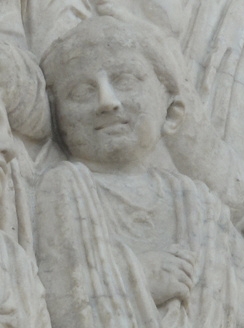Lunula (amulet) on:
[Wikipedia]
[Google]
[Amazon]
 A ''lunula'' (plural: ''lunulae'') was a
A ''lunula'' (plural: ''lunulae'') was a
crescent
A crescent shape (, ) is a symbol or emblem used to represent the lunar phase in the first quarter (the "sickle moon"), or by extension a symbol representing the Moon itself.
In Hinduism, Lord Shiva is often shown wearing a crescent moon on his ...
moon
The Moon is Earth's only natural satellite. It is the fifth largest satellite in the Solar System and the largest and most massive relative to its parent planet, with a diameter about one-quarter that of Earth (comparable to the width of ...
shaped pendant
A pendant is a loose-hanging piece of jewellery, generally attached by a small loop to a necklace, which may be known as a "pendant necklace". A pendant earring is an earring with a piece hanging down. Its name stems from the Latin word ' ...
worn by girls in ancient Rome
In modern historiography, ancient Rome refers to Roman people, Roman civilisation from the founding of the city of Rome in the 8th century BC to the collapse of the Western Roman Empire in the 5th century AD. It encompasses the Roman Kingdom ...
. Girls ideally wore them as an apotropaic
Apotropaic magic (from Greek "to ward off") or protective magic is a type of magic intended to turn away harm or evil influences, as in deflecting misfortune or averting the evil eye. Apotropaic observances may also be practiced out of superst ...
amulet
An amulet, also known as a good luck charm or phylactery, is an object believed to confer protection upon its possessor. The word "amulet" comes from the Latin word amuletum, which Pliny's ''Natural History'' describes as "an object that protect ...
, the equivalent of the boy's bulla
Bulla (Latin, 'bubble') may refer to:
Science and medicine
* Bulla (dermatology), a bulla
* Bulla, a focal lung pneumatosis, an air pocket in the lung
* Auditory bulla, a hollow bony structure on the skull enclosing the ear
* Ethmoid bulla, pa ...
. In the popular belief the Roman
Roman or Romans most often refers to:
* Rome, the capital city of Italy
* Ancient Rome, Roman civilization from 8th century BC to 5th century AD
*Roman people, the people of ancient Rome
*''Epistle to the Romans'', shortened to ''Romans'', a lett ...
s wore amulets usually as a talisman
A talisman is any object ascribed with religious or magical powers intended to protect, heal, or harm individuals for whom they are made. Talismans are often portable objects carried on someone in a variety of ways, but can also be installed perm ...
, to protect themselves against evil forces, demons and sorcery, but especially against the evil eye
The Evil Eye ( grc, ὀφθαλμὸς βάσκανος; grc-koi, ὀφθαλμὸς πονηρός; el, (κακό) μάτι; he, עַיִן הָרָע, ; Romanian: ''Deochi''; it, malocchio; es, mal de ojo; pt, mau-olhado, olho gordo; ar ...
.
In Plautus
Titus Maccius Plautus (; c. 254 – 184 BC), commonly known as Plautus, was a Roman playwright of the Old Latin period. His comedies are the earliest Latin literary works to have survived in their entirety. He wrote Palliata comoedia, the g ...
' play, Epidicus asks the young girl Telestis: "Don't you remember my bringing you a gold lunula on your birthday, and a little gold ring for your finger?" An explicit definition is provided by Isidore of Seville
Isidore of Seville ( la, Isidorus Hispalensis; c. 560 – 4 April 636) was a Spanish scholar, theologian, and archbishop of Seville. He is widely regarded, in the words of 19th-century historian Montalembert, as "the last scholar of ...
: "Lunulae are female ornaments in the likeness of the moon, little hanging gold bullae." But in Plautus' play ''Rudens'', Palaestra says her father gave her a golden bulla on the day of her birth.
See also
*Gold lunula
The Gold lunula (plural: lunulae) is a distinctive type of late Neolithic, Chalcolithic or (most often) early Bronze Age necklace or collar shaped like a crescent moon; most are from Prehistoric Ireland. They are normally flat and thin, with ...
References
* * {{cite book , author=Kelly Olson (classicist)
Kelly Olson is a Canadian Classicist. She is Professor and Acting Chair in the Department of Classical Studies at the University of Western Ontario.
Olson earned her PhD from University of Chicago in 1999. Her thesis was entitled ''Fashioning the ...
, year= 2008 , title= Dress and the Roman Woman: Self-Presentation and Society , url= https://books.google.com/books?id=_AbrRe88Z4YC , publisher= Routledge , isbn=978-0-415-41476-0 , pages=16, 18
Ancient Roman culture
Amulets
Necklaces